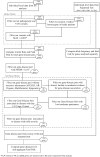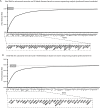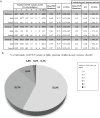Optimizing clinical exome design and parallel gene-testing for recessive genetic conditions in preconception carrier screening: Translational research genomic data from 14,125 exomes
- PMID: 31589614
- PMCID: PMC6797235
- DOI: 10.1371/journal.pgen.1008409
Optimizing clinical exome design and parallel gene-testing for recessive genetic conditions in preconception carrier screening: Translational research genomic data from 14,125 exomes
Abstract
Limited translational genomic research data have been reported on the application of exome sequencing and parallel gene testing for preconception carrier screening (PCS). Here, we present individual-level data from a large PCS program in which exome sequencing was routinely performed on either gamete donors (5,845) or infertile patients (8,280) undergoing in vitro fertilization (IVF) treatment without any known family history of inheritable genetic conditions. Individual-level data on pathogenic variants were used to define conditions for PCS based on criteria for severity, penetrance, inheritance pattern, and age of onset. Fetal risk was defined based on actual carrier frequency data accounting for the specific inheritance pattern (fetal disease risk, FDR). In addition, large-scale application of exome sequencing for PCS allowed a deep investigation of the incidence of medically actionable secondary findings in this population. Exome sequencing achieved remarkable clinical sensitivity for reproductive risk of highly penetrant childhood-onset disorders (1/337 conceptions) through analysis of 114 selected gene-condition pairs. A significant contribution to fetal disease risk was observed for rare (carrier rate < 1:100) and X-linked conditions (16.7% and 41.2% of total FDR, respectively). Subgroup analysis of 776 IVF couples identified 37 at increased reproductive risk (4.8%; 95% CI = 3.4-6.5). Further, two additional couples had increased risk for very rare conditions when both members of a parental pair were treated as a unit and the search was extended to the entire exome. About 2.3% of participants showed at least one pathogenic variant for genes included in the updated American College of Medical Genetics and Genomics v2.0 list of secondary findings. Gamete donors and IVF couples showed similar carrier burden for both carrier screening and secondary findings, indicating no causal relationship to fertility. These translational research data will facilitate development of more effective PCS strategies that maximize clinical sensitivity with minimal counterproductive effects.
Conflict of interest statement
I have read the journal's policy and the authors of this manuscript have the following competing interests: all authors are full time employees of igenomix.
Figures




References
MeSH terms
LinkOut - more resources
Full Text Sources
Other Literature Sources
Medical
Molecular Biology Databases

